Nordic Discovery
Freya – The Norse Goddess of Love, War, and Magic
In Norse mythology, no figure embodies divine femininity, sensual power, and martial strength quite like Freya. A goddess of love, beauty, fertility and also of war, death, and magic Freya holds a complex and commanding place among the Viking pantheon.
She is not only worshipped as a bringer of desire and prosperity but also respected as a fierce warrior and wielder of seidr, a form of powerful Norse magic. In this article, we uncover the many faces of Freya, her myths, attributes, and how she became one of the most revered goddesses in Norse lore.
Who Is Freya?
Freya (Old Norse: Freyja, meaning “Lady”) is a member of the Vanir tribe of gods, associated with nature and fertility, who later lives among the Aesir after a peace treaty. She is the twin sister of Freyr, and daughter of the sea god Njord.
Known for her beauty and independence, Freya drives a chariot pulled by cats, wears the shimmering necklace Brísingamen, and owns a cloak of falcon feathers that allows her to fly between realms.
Attributes and Symbols of Freya
- Love and Fertility: Freya is invoked in matters of love, passion, marriage, and childbirth.
- War and Death: She chooses half of the fallen warriors from the battlefield to dwell in her hall, Fólkvangr the other half go to Odin’s Valhalla.
- Magic (Seidr): Freya is the foremost practitioner of seidr, a type of Norse sorcery that can shape fate and destiny.
- Brísingamen Necklace: A symbol of beauty and power, often sought after by gods and giants alike.
- Cats and Boar: Her sacred animals are two large cats and a boar named Hildisvíni, both symbolic of fertility and protection.
Freya’s Role in Norse Mythology
Freya appears in numerous myths that illustrate her dual nature:
- Mistress of Magic: She teaches Odin the art of seidr, making her a bridge between the mystical and martial worlds.
- Search for Óðr: Her husband, Óðr, disappears and Freya weeps tears of red gold, symbolizing her grief and eternal longing. This story reflects themes of love, loss, and loyalty.
- Fólkvangr Hall: Freya’s domain receives brave warriors who fall in battle. Here, they enjoy peace and honor, making Freya a goddess of valor as much as of love.
Freya vs. Frigg: Are They the Same?
In Norse texts, Freya and Frigg (Odin’s wife) share similar traits: both are goddesses associated with love and prophecy. Some scholars argue they may have once been the same deity, later split into two figures. However, Freya’s links to war and magic set her apart as a more dynamic and independent figure.
Worship and Legacy
Freya was among the most beloved deities of the Viking Age:
- Temples and sacrifices were dedicated to her for fertility, harvest, and love.
- The day Friday (Freya’s day) is named in her honor.
- Her image appears in modern paganism, literature, art, and pop culture from Viking tattoos to TV series and fantasy novels.
She remains a powerful icon of empowered femininity, spiritual insight, and fearless independence.
Freya in Modern Culture
Freya’s influence continues in modern interpretations of Norse mythology:
- In Marvel comics, she is reimagined as a warrior goddess.
- In video games like God of War, Freya is portrayed as both nurturing and dangerous.
- In neopaganism, she is worshipped as a symbol of divine feminine energy and magic.
These portrayals highlight her lasting appeal as a deity who transcends traditional roles and embraces paradox.
Conclusion
Freya is not just a goddess of love she is a goddess of contradictions: life and death, beauty and power, grief and strength. Her presence in Norse mythology teaches that to be powerful is to be whole to embrace passion, magic, and war with equal grace.


